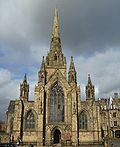History
The foundation stone for the town hall was laid by Lord Bexley, Chancellor of the Duchy of Lancaster in August 1825. [2] The square in which the building now stands was named after him. [3] It was designed by Richard Lane in the Neo-classical style and completed in 1827. [1] The building, which was originally constructed as a market hall, [4] became the Salford's town hall in 1835 and, additionally, a courthouse in 1840. [4] The building was expanded three times in the nineteenth century. [4]
In January 1878 it was the place where local hero Mark Addy received several awards for his gallantry in saving people from drowning in the River Irwell. [5] On 1 October 1931 it was the scene of the 'Battle of Bexley Square' where 10,000 protesters of the Salford Branch of the National Unemployed Workers' Movement clashed with police, an event which is commemorated with a plaque on the building. [6] [7] The novelist Walter Greenwood was present at the demonstration and a similar event is portrayed in his novel "Love on the Dole". [8]
The building became the headquarters of the County Borough of Salford and continued to be called Salford Town Hall, notwithstanding that Salford was granted city status in 1926. [9] [10] It ceased to be the local seat of government when the county borough was abolished by the Local Government Act 1972 [11] and Swinton and Pendlebury Town Hall became the meeting place for the enlarged local authority area, known as the City of Salford, in 1974. [12]
Salford Town Hall was used as a court house until the last two court rooms closed in December 2011. [4] It was subsequently sold to private developers, who completed converting the building into apartments in November 2015. [13]
This page is based on this
Wikipedia article Text is available under the
CC BY-SA 4.0 license; additional terms may apply.
Images, videos and audio are available under their respective licenses.





